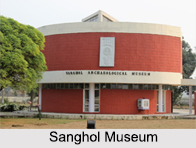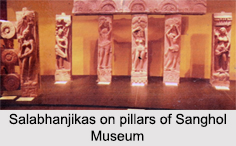 Sanghol Museum is situated in Sanghol. It is a small village in Fatehgarh Sahib District of Punjab. Being a site of Harappan civilization, Sanhgol has furnished a number of ancient artifacts through excavations, which have been displayed in the Sanghol Museum. The museum was established on 10th of April, 1990 by the Government of Punjab.
Sanghol Museum is situated in Sanghol. It is a small village in Fatehgarh Sahib District of Punjab. Being a site of Harappan civilization, Sanhgol has furnished a number of ancient artifacts through excavations, which have been displayed in the Sanghol Museum. The museum was established on 10th of April, 1990 by the Government of Punjab.
The rich cultural heritage of the state can be aptly traced among the archaeological treasures and exhibits of Sanghol museum which have been well preserved and displayed here. Archaeological excavations at Sanhgol have rendered about 15000 ancient artifacts. A great variety can be witnessed among these antiquities which include pottery, coins, sealing, terracotta, ivory, sculptures, seals, precious stones, carvings and other specimens of art.
Exhibits in Sanghol Museum
At the entrance, a master chart narrates the brief history and significance of Sanghol as an archaeological site. On the ground floor of Sanghol museum, a variety of important articles have been displayed. These articles have been arranged according to the chronology that reflects the social as well as cultural development of the state. Radio-carbon tests have confirmed that the articles also belong to Sungas, Mauryas, Guptas and Muslim cultures.
 The ground floor also houses photographs, graphs, drawings, maps and charts to provide a better understanding of the displayed objects. Identity and chronological position of every artifact has been mentioned on a label given to each item.
The ground floor also houses photographs, graphs, drawings, maps and charts to provide a better understanding of the displayed objects. Identity and chronological position of every artifact has been mentioned on a label given to each item.
The various items of display in the museum include pottery belonging to the Harappan culture, dating back to 2000-1200 B.C. The potteries are the testaments of excellent craftsmanship which are evident in their fine texture and intricate carvings. Apart from pottery; other exhibits include seals, moulds and coins. These are primarily made of copper, ivory, unbaked clay, lead and stones and contain inscriptions in Kharosthi and Brahmi scripts belonging to first and second century AD.
Ground floor also houses a seal where the name of the Huna King of 5th century AD is inscribed which provides some evidences that the King might have had a crucial role in destroying the Buddhist establishments, the remains of which have been found in the village. Other artifacts displayed here are terracotta toys, beads, metal, steatite, bangles, ivory and glass items. Sandstone images of various deities are also highly attractive.
First floor of Sanghol museum hosts mottled red sandstone sculptures excavated from Sanghol. These include railings, pillars and crossbars with beautiful motifs and figures carved on them which form the glory of the place. The sculptures represent a number of beautiful themes including Buddhist Jataka tales, mother and child motifs, Shalabhanjika, Surasundaris and many more.
Kushana style of artistry, belonging to 2nd -3rd Century AD, of Mathura School of Art is quite prominent in the sculptures. These are the evidences of artistic mastery that prevailed among the artisans of this region. Some of these specimens are also displayed all over the world in different exhibitions. The architectural discoveries of this region have immensely contributed in depicting the cultural diversity of the country. They helped the art to reach the pinnacle of excellence in that region.
Visiting information to Sanghol Museum
In Sanghol museum, only certain selected objects have been put on display. Scholars, historians and art lovers can access other artifacts only with special permission from museum authority.



















